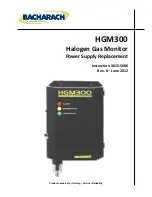
SMART S
MANUALE D'INSTALLAZIONE E USO
INSTALLATION AND USER MANUAL
MT3567rev2
13/12/2019
Page 14 of 18
3.7
Collegamento con schede opzionali
3.7
Connection to optional boards
In fase di configurazione della versione display del
rilevatore SMART S è possibile associare le soglie di
allarme 1, 2, 3 ed il guasto alla scheda STRS3REL
opzionale.
Di default le soglie d’allarme sono così associate: guasto
relè1; allarme 1 relè 2; allarme 2 relè 3.
During the SMART S-SS display configuration, you can
associate the alarm thresholds 1, 2, 3 and fault to
STRS3REL relay board.
By default, the alarm thresholds are associated as: Fault
relay 1; alarm1 relay 2; alarm2 relay 3.
4
COLLAUDO E USO
4
TESTING AND USE
4.1
Accensione
4.1
Power ON
Al momento in cui il rivelatore viene alimentato, si
accende, ad intermittenza lenta il LED rosso sulla scheda
base. L’uscita in corrente è 2 mA circa.
Trascorsi 2 minuti circa, il LED rosso lampeggia con una
frequenza pari allo stato in cui si trova il rilevatore (vedere
tabella al punto 4.3) e l’uscita in corrente è a 4,0mA.
Terminata la fase di preriscaldamento il rivelatore è in
grado di funzionare correttamente, anche se sono
comunque necessarie 2 ore circa affinché il rilevatore
raggiunga le prestazioni ottimali.
Se il rivelatore è provvisto di scheda display, consultare il
manuale aggiuntivo fornito con gli SMART S-SS.
When the detector is powered on, the red LED on the
motherboard starts blinking at slow intermittence. Output
current is nearly 2 mA.
After nearly two minutes, the red LED flash rate is
equivalent to the detector working status (see table on
paragraph 4.3) and the output current is 4.0mA.
Once the warm-up phase is over, the detector can work
correctly, although the optimal performances will be
achieved after two hours.
Should the detector be provided with display, please refer
to the additional technical handbook supplied along with
the SMART S-SS.
4.2
Collaudo
4.2
Testing
Il rilevatore viene tarato in fabbrica per il gas
specificamente richiesto dal cliente. Successivamente è
possibile controllare e eventualmente correggerne la
taratura utilizzando l’apposita tastiera di calibrazione.
Verificare la risposta del rivelatore utilizzando una miscela
a composizione nota gas/aria, e l'apposito KIT di taratura.
Lo strumento non ha regolazioni (potenziometro etc.), i
controlli dello zero e dello span si eseguono per lo
SMART S-MS con la tastiera di calibrazione STS/CKD-PK
e per lo SMART S-SS con il display ed i magneti.
Per entrambe le versioni SMART S-MS e SMART S-SS la
calibrazione si esegue con un KIT comprendente:
• Bombola gas di test
• Valvola con Flussimetro
• Adattatore di calibrazione
Vedi manuale
MT3561 “tastiera di calibrazione”
Vedi addendum MT3771
“display”
Vedi manuale MT894 “KIT di calibrazione” ed il paragrafo
7 di questo manuale.
Detectors are factory calibrated for the specific gas
required by the customers. Future adjustment of the
preset calibration can be carried out by employing the
calibration keypad.
Testing should be carried out by using a gas mixture in
the appropriate range, along with our calibration kit.
The instrument has no adjustments (potentiometer etc.),
the zero and the span checks are performed for the
SMART S-MS with the calibration keypad STS/CKD-PK
and the SMART S-SS with the display and the magnets.
For both SMART S-MS and SMART S-SS versions, the
calibration is performed with a KIT comprising:
• Test gas bottle
• Valve with flowmeter
• Calibration adapter
See MT3561 manual "calibration keypad"
See MT3771 addendum "display"
See MT894 manual " calibration KIT " and paragraph 7 of
this manual.
4.3
Uso
4.3
Use
Il rivelatore funziona automaticamente e autonomamente,
pertanto non è richiesto alcun contributo da parte del suo
utilizzatore.
Il LED rosso lampeggiante posto sulla scheda base del
circuito indica lo stato in cui il rilevatore si trova come
illustrato nella tabella sottostante.
Assicurarsi che la segnalazione dello stato di over-range
del rivelatore venga prevista, come indicato dalla norma
EN60079-29-1:2016, paragrafo 4.2.2.3.
The detector works autonomously and automatically.
Once adequately connected, no further operations are
required.
The flashing red LED on the motherboard indicates the
detector's working condition as detailed in the following
table.
Make sure the over-range status of the detector is
indicated or signalled, as clearly defined by the standard
EN60079-29-1:2016 paragraph 4.2.2.3.




































